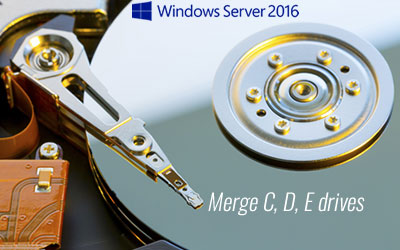There are 2 main benefits to merge partitions in Windows 2016 server: reduce partition number and expand a partition by transfer free space from the other one. This article introduces how to combine D and E drive, merge C and E drive or merge C and D drive in Windows Server 2016. If you want to extend a partition by merging another one, it is better to resize partition rather than merging them together.

How to merge D and E drive in Server 2016 without software
If D and E are contiguous and on the same disk, you can combine drive E to D without any software. Windows Server 2016 Disk Management has no merge volume function, but it can realize indirectly with another "Extend Volume" function.
Steps to merge D and E drive in Windows Server 2016/2019/2022:
- Transfer all files in drive E to D.
- Press Windows + X together on the keyboard and click Disk Management in the list.
- Right click E: drive and select Delete Volume.
- Right click D: drive and select Extend Volume.
- Simply click Next till Finish in the pop-up Extend Volume Wizard windows.
It is easy to combine D and E drive in Server 2016/2019/2022 when they are contiguous, but there are some limitations to merge partitions with Disk Management:
- There should be plenty of free space in drive D (or other volume) to save all files of E.
- Disk Management can only merge 2 adjacent partitions. In addition, it can only combine the right partition to the left one.
- Drive D must be formatted with NTFS file system.
- D and E must be the same Primary or Logical drive. (On MBR disk)
With NIUBI Partition Editor, there are no such limitations, you can merge 2 contiguous partitions via several clicks, no matter the partitions are NTFS or FAT32, Primary or Logical. In addition, you don't need to transfer files manually. Files in a partition will be moved to a folder in root directory of the other one automatically.
How to merge C and D drive in Server 2016 when they are adjacent:
- Download NIUBI Partition Editor, right click either C or D drive and select "Merge Volume".
- Click the check-box in front of both C and D drive.
- Click OK and back to the main window, click Apply on top left to execute, done.
Watch the video how to operate:
How to merge C and E drive when they are nonadjacent
If C and E drive are contiguous in your server, follow the steps above to combine these partitions. But if C and E drive are nonadjacent, no software can combine them directly. You need to delete E drive manually and then merge unallocated space to C drive.
Steps to merge C and E drive in Windows Server 2016/2019/2022:
- Right click E: drive in NIUBI Partition Editor and select "Delete Volume", then its disk space will be changed to unallocated.
- Right click D: drive and select "Resize/Move Volume", drag the middle of this partition towards right in the pop-up window, then unallocated space will be moved to the left.
- Right click C: drive and select "Resize/Move Volume" again, drag right border towards right to merge this contiguous unallocated space. Remember to click "Apply" to take effect.
Consider resizing instead of merging C and D drive
If your aim is to extend C drive, it is not suggested to merge C and D drive in Windows 2016 server. There's better method with NIUBI Partition Editor. You can shrink D, E or any partition on the same disk to get unallocated space, and then add this unallocated space to C drive. In this way, you won't lose any partition. Operating system, programs and anything else (except size) keep exactly the same with before.
How to extend a partition by shrinking another one:
If you use SSD or any types of hardware RAID array, or run Windows 2016 server in VMware/Hyper-V, the steps are the same.
Better than other tools, NIUBI Partition Editor has innovative Virtual Mode, Cancel-at-will, Hot-Clone and 1-Second Rollback technologies to protect system and data. Besides merging partitions in Windows Server 2016/2019/2025/2003/2008/2012, it helps do many other disk/partition management operations.

